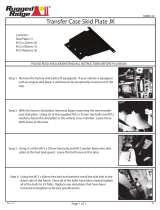
v.170626 En.15
OPERATION
positioned at an angle to the left and to the right of the line of travel or straight
across the front of the vehicle. Releasing the handle will allow the spring-loaded
pin to fall into the appropriate hole in the back of the D frame to hold its position
3. After the rst use, it is recommended that all bolts in the assembly are checked
and re-tightened.
4. 2-wheel-drive vehicles and some others may have lower clearance. This will
likely be further reduced by the front mount as well as the added weight of the
plow. You may feel it helpful to adding spring height or increasing tire size to
provide extra clearance needed. Though plowing ability will not be aected,
because of its extension ahead of the front wheels, there is an increased
likelihood of catching the plow assembly on raised or uneven surfaces.
5. This plow was intended to ease the clearance of newly fallen snow. The
DK2 Snow Plow is not intended to clear the snow deposits created by large
municipal or commercial snowplows, which contain heavy compacted, frozen
lumps of snow and ice, and could damage the plow and vehicle. Do not use it
for removing or pushing excessive amounts of snow, nor for ice, sand or gravel.
6. Mainly because of the design of the blade elevation and lowering mechanism,
back-dragging with this unit is not practical nor recommended.
WARNING! With heavier, full-sized vehicles, mainly through momentum, it
may be easier to damage the plow assembly. Cautious use will help extend your
years of trouble-free service.
PLOWING INSTRUCTIONS
The DK2 Snow Plow is intended for light personal use. It will eectively remove
snow from parking lots, lanes, and driveways.
To ensure long life for your snow plow, please observe these
fundamental instructions and notes:
1. Before beginning to plow, always check the main frame and the custom mount
are correctly installed and secured using the two quick mount locking plates.
Pull strongly forward on the plow. It should not move out of the front mount.
2. In heavy, continuing snowfalls, do not delay; plow regularly every 8 to 15 cm
(3 to 6 inches) of snow accumulation. With heavy, wet snow increase the
frequency.
3. To plow higher snow drifts, raise the blade and remove layer of snow from the
top, lowering the blade by degrees on successive passes until the full depth is
removed.
4. Do not allow the snow to become icy. Plowing immediately after each snowfall
reduces the possibility the plow be used to break through ice.
5. Be familiar with the area being plowed or have someone who is familiar point
out hazards. Exercise caution because hidden obstacles can inict severe
damage to both plow and vehicle.
6. Keep a distance of a metre (3 ft.) from obstacles such as building walls,
telephone poles, and gates because the vehicle may slip sideways and cause
the plow to contact them.
7. Ramming into a pile of snow will void your warranty and may cause damage to
your vehicle. This plow is not designed for ice blocks
8. Do not attempt plowing snow at speeds above 15 km/h (10 mph). Faster may
overload the unit or contribute to loss of control of the vehicle.
9. Should the plow appear to hop when plowing, a reduction in speed is
recommended.
10. The DK2 Snow Plow will, by design, trip forward if overloaded or on striking
an obstacle buried under the snow. The trip springs will then pull it back to the
correct position. Before carrying on with caution, it is prudent to search out any
hidden obstacles.























